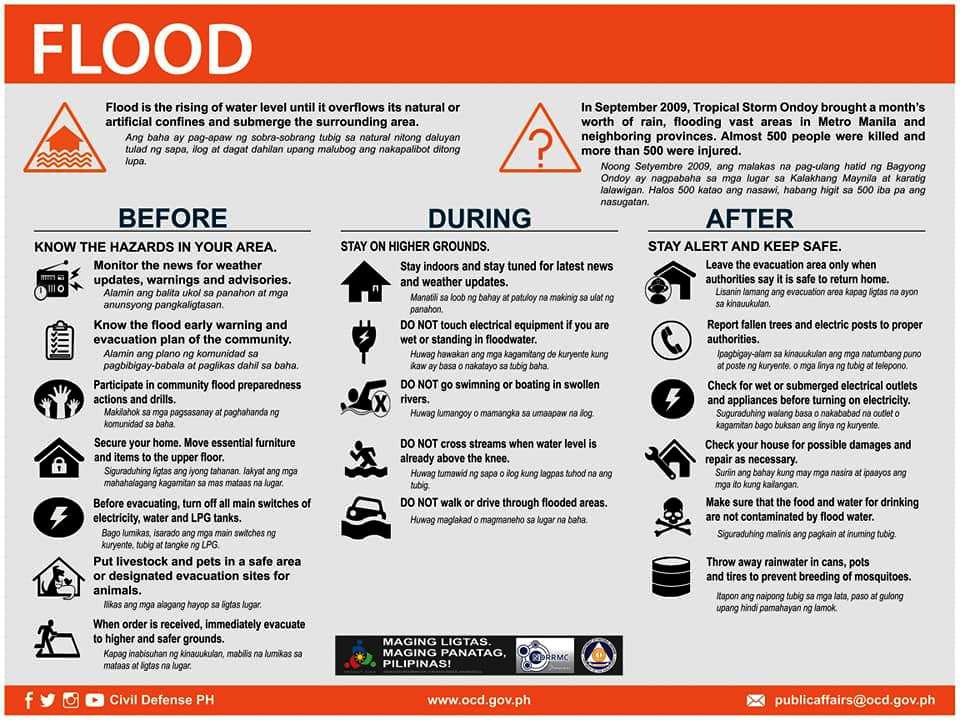Staying Safe During Flash Floods: A Guide To Flood Warnings And Preparedness

Table of Contents
Understanding Flash Flood Warnings and Alerts
Flash floods can develop rapidly, often within hours of heavy rainfall or dam failures. Knowing the difference between various flood alerts is critical for timely response. The National Weather Service (NWS) issues several types of alerts:
-
Flash Flood Watch: Conditions are favorable for flash flooding. Be prepared to act quickly if flooding begins. This is a time to review your emergency plan and ensure your flood preparedness measures are in place.
-
Flash Flood Warning: Flash flooding is occurring or is imminent. Take immediate action to protect yourself and your property. Evacuate if instructed to do so. This is not the time to wait and see.
-
Flash Flood Advisory: Flash flooding is possible. Stay informed and monitor the situation closely. Be aware of potentially hazardous conditions and take necessary precautions.
Receiving timely warnings is crucial. Utilize several methods:
- Sign up for emergency alerts: Most local governments offer a system to send alerts directly to your phone.
- Download a weather app: Many reputable weather apps provide real-time alerts and severe weather notifications.
- Keep a battery-powered NOAA weather radio handy: This is an invaluable tool during power outages, providing continuous updates.
- Know your elevation: Understanding your property's elevation and the surrounding topography helps you assess your risk.
- Understand NWS warning levels: Familiarize yourself with the different warning levels and their implications for your safety.
Creating a Flash Flood Preparedness Plan
A comprehensive flash flood preparedness plan is your first line of defense. It should outline clear steps to take before, during, and after a flash flood event. This isn't just about protecting your belongings; it's about safeguarding lives.
- Develop an evacuation plan: Include multiple evacuation routes, considering potential road closures.
- Identify safe evacuation locations: Choose high-ground locations or designated emergency shelters. Know the location of these beforehand.
- Pack a go-bag: This emergency kit should contain essential supplies, like water (at least one gallon per person per day), non-perishable food, a first-aid kit, medications, flashlights, batteries, and important documents. This flood kit should be easily accessible and readily available.
- Designate an out-of-state contact: This person serves as a central point for family members to check in with, ensuring everyone is accounted for.
- Practice your plan: Regularly review and practice your evacuation plan with your family so everyone knows what to do. This drills in the importance of the flood safety plan and familiarizes everyone with the procedures.
Building a Flood Emergency Kit
Your flood emergency kit is your lifeline during a flash flood. Ensure it's adequately stocked for several days of self-sufficiency. Key items include:
- Water: At least one gallon per person per day for several days.
- Food: Non-perishable items like canned goods, energy bars, and dried fruit.
- First-aid kit: Include bandages, antiseptic wipes, pain relievers, and any necessary prescription medications.
- Flashlights and batteries: Essential for navigating darkness and locating supplies.
- Radio: A battery-powered NOAA weather radio for updates during power outages.
- Important documents: Copies of identification, insurance policies, and medical records.
- Water purification tablets or a filter: Crucial if your drinking water sources become contaminated.
- Whistle: To signal for help if needed.
Staying Safe During a Flash Flood
When a flash flood warning is issued, act immediately. Your safety is paramount.
-
Never drive or walk through floodwaters: Floodwaters can be deceptively deep and fast-moving, hiding dangers beneath the surface. "Turn around, don't drown!" is a crucial mantra to remember. Driving through floodwater can lead to devastating consequences, from vehicle damage to serious injury or death.
-
Move to higher ground immediately: If you're in a low-lying area, seek higher ground as quickly and safely as possible. Don't wait until the floodwaters reach you; evacuation is crucial.
-
Avoid flooded roads and bridges: Floodwaters can undermine roads and bridges, making them unstable and dangerous.
-
Listen to emergency broadcasts: Stay informed about the flood situation and follow any instructions from emergency officials. This ensures that you receive accurate and up-to-date information.
-
If trapped, seek higher ground and call emergency services: If you become trapped, try to find a safe place above the waterline and call for help immediately. This ensures swift rescue and assistance in life-threatening situations.
Post-Flood Safety and Recovery
After a flash flood, safety remains a priority. Floodwaters often contain contaminants, posing health risks.
-
Avoid contact with floodwater: Floodwater can be contaminated with sewage, chemicals, and other hazardous materials. Avoid walking or wading through it.
-
Have your home professionally inspected: Structural damage may not be immediately apparent, requiring a professional assessment to identify safety risks. This prevents further damage and ensures your safety.
-
Contact your insurance company: File a claim promptly to begin the process of repairing flood damage. Documenting everything is essential.
-
Look for resources from FEMA and other disaster relief organizations: These organizations provide essential aid during the flood recovery process. Utilizing resources is crucial for financial and physical recovery.
-
Document all damages with photos and videos: This documentation is critical for insurance claims and aid applications.
Conclusion
Staying safe during flash floods requires proactive preparedness and a clear understanding of flood warnings. By developing a comprehensive plan, building an emergency kit, and following safety guidelines, you can significantly reduce your risk and protect yourself and your loved ones. Don't wait for a flash flood to strike. Start planning for flash flood safety today. Create your emergency plan and gather your supplies to ensure you're prepared for any flood warning. Learn more about effective flash flood preparedness and stay safe.

Featured Posts
-
 Officially Opened Ferraris First Service Centre In Bengaluru
May 25, 2025
Officially Opened Ferraris First Service Centre In Bengaluru
May 25, 2025 -
 2 Drop In Amsterdam Stock Exchange Following Trumps Latest Tariffs
May 25, 2025
2 Drop In Amsterdam Stock Exchange Following Trumps Latest Tariffs
May 25, 2025 -
 La Charentaise Histoire D Une Reussite A Saint Brieuc
May 25, 2025
La Charentaise Histoire D Une Reussite A Saint Brieuc
May 25, 2025 -
 Brest Urban Trail Benevoles Artistes Et Partenaires Au C Ur De L Evenement
May 25, 2025
Brest Urban Trail Benevoles Artistes Et Partenaires Au C Ur De L Evenement
May 25, 2025 -
 El Estilo En El Baile De La Rosa 2025 Alexandra De Hannover Y Los Mejores Atuendos
May 25, 2025
El Estilo En El Baile De La Rosa 2025 Alexandra De Hannover Y Los Mejores Atuendos
May 25, 2025
